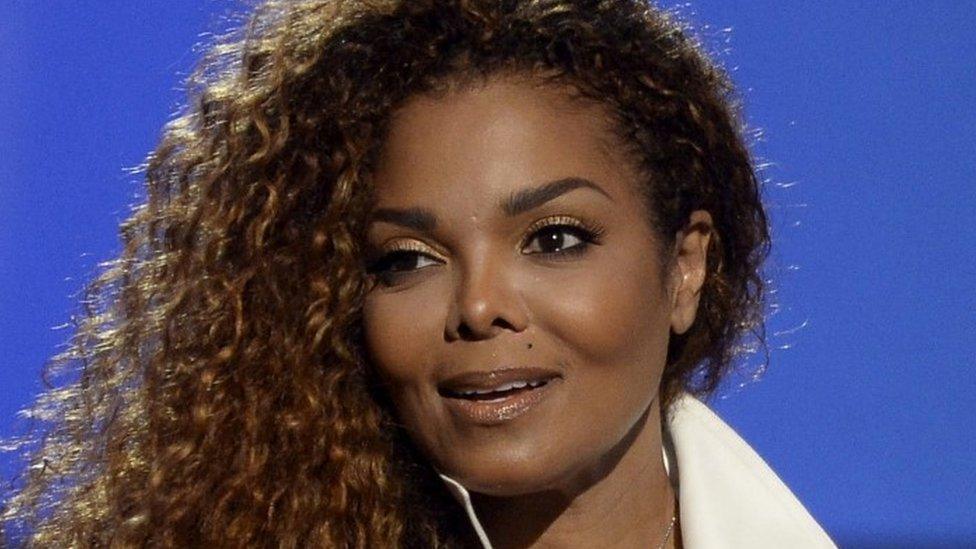Raised on Janet Jackson: How the pop star shaped one fan's life
- Published
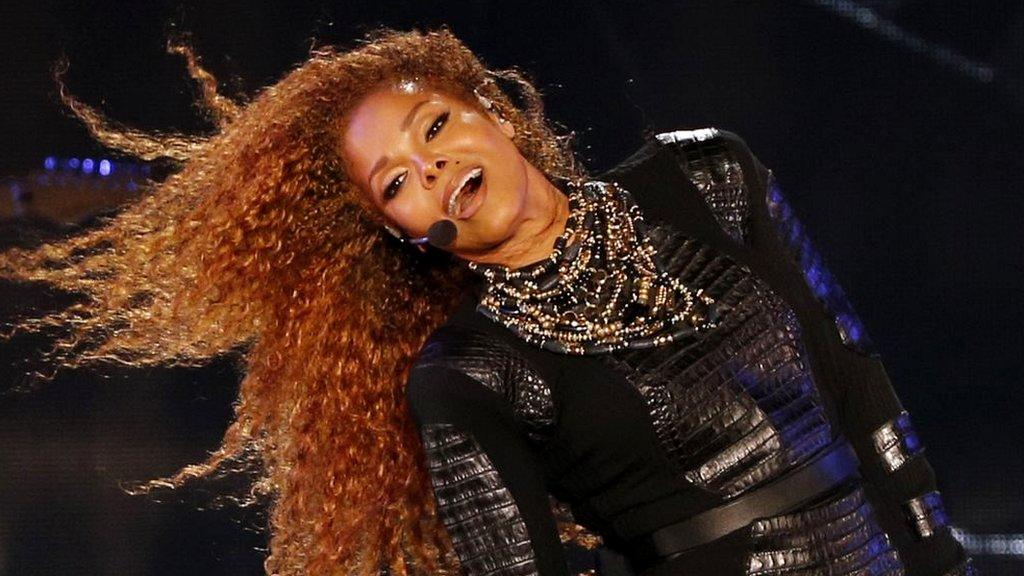
The State of the World tour is a re-formatted version of Janet's Unbreakable tour, which was put on hold when she became pregnant
Janet Jackson plays the last date of her State of the World tour in Atlanta this Sunday.
Staged less than a year after the birth to her first child, its a powerful return, external - condemning domestic terrorism, white supremacy and police brutality with a sense of urgency and alarm.
The political nature of the production is supported by the musical choices, which highlight socially-conscious album tracks like The Knowledge and What About alongside Jackson's 28 top 10 hits.
It's earned the star some of the best reviews, external of her career, external, and rekindled many fans' enthusiasm. Among them is Christine Cardona, who reflects here on her relationship with the singer.

I recently found myself with a lapful of beignets, giddy with a childish excitement, in the backseat of a rental car. A few hours earlier, I'd flown from my home in New York to New Orleans, collected a friend in each airport, and started the two-hour drive to Lafayette for the opening night of Janet Jackson's State of the World Tour.
As our "Ultimate Janet" playlist pumped through the speakers, I had flashbacks to the many drives, and the countless buses, trains and planes I'd boarded for a glimpse of Janet Jackson. I tried to remember how it all began.
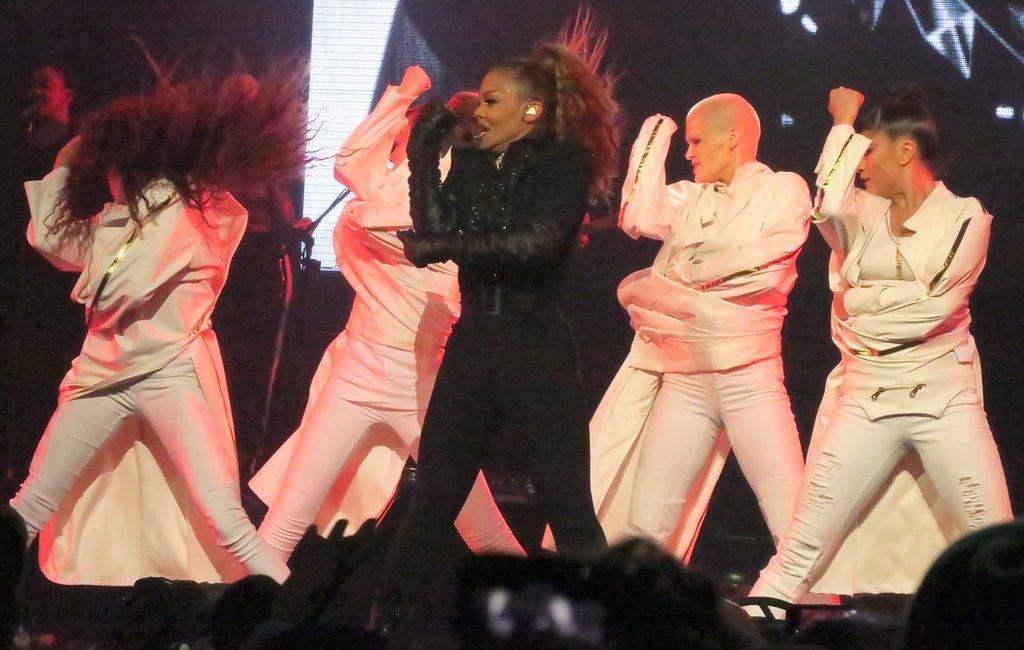
The State of the World tour sees the star reinvigorated
It was the mid-90s and I was not quite a teenager. MTV was thriving and Janet's video for Again, external was in heavy rotation. It made me feel things I wouldn't understand for years to come. It was soft. So soft. So sensual, so strong, so… feminine.
I felt something when Gary Dourdan (Janet's love interest in the video) gently circled his hand around her washboard abs. My heart sank a little when her voice broke with longing, and her doe-eyes begged to be held. Somewhere deep in the recesses of my impressionable, adolescent brain I filed this away as "Woman."
Not long after, Janet released her first greatest hits album, Design of a Decade. I saved my allowance money to purchase it. To my disappointment, Again was not on the track listing. Instead, there was a whole catalogue of songs I was only half-aware of. I began to work my way backwards through the albums that led to this compilation.
What Have You Done For Me Lately?
The bold sexuality of 1993's Janet is apparent at first glance. The album cover, famously, shows the star topless, her breasts covered by her then-partner's hands. My friend and I used to sit and read the lyrics until we had them committed to memory. I knew early on the actual words she sang in If, but I also remember the specific moment when I realised, with shock, exactly they meant.
But it wasn't just sex. On You Want This, external her confidence is relentless. It remains an enormously underrated song of female empowerment.
Then there was the social consciousness of 1989's Rhythm Nation. My discovery of this album coincided with my introduction to the African-American History curriculum, or as much of it as a suburban public school in a largely white community teaches. I wrote school papers on social and racial injustices, quoting Janet's lyrics. I can now only imagine the eye rolls that must have accompanied the grading of them, but everyone at least seemed to appreciate my passion.
Allow YouTube content?
This article contains content provided by Google YouTube. We ask for your permission before anything is loaded, as they may be using cookies and other technologies. You may want to read Google’s cookie policy, external and privacy policy, external before accepting. To view this content choose ‘accept and continue’.
And there was Janet's breakthrough album, Control, with its message of emancipation and independence. It's easy to understand how a teenager would latch onto that one.
By the time 1997's Velvet Rope album rolled around, I was acting in real time. I purchased it at midnight on its release date, 20 years ago this past October. The cover features Janet's bright red curls bowed down in... what? Reflection? Meditation? Gratitude?
I listened to it alone, on headphones, in the privacy of my own bedroom, which at the time was a small shrine to Janet - posters plastered on the walls, the floors carpeted in piles of magazines.
With themes of self-awareness, loneliness, and sexual exploration, the album mirrored feelings I wasn't even aware I was having. At 15, I was just figuring out who I was. I was navigating the ups and downs of my teenage years, exploring my emotions, learning my own body, finding my way.

The Velvet Rope is one of Janet's most intimate albums, discussing depression, death, resilience and sexuality
When the Velvet Rope Tour hit Detroit, Michigan in the summer of 1998, it would be my first concert. Looking back now, I realize this trip was one of my first true experiences with diversity - the kind that my suburban New Jersey upbringing hadn't really offered. The people, both in my group and the general audience, were of varying backgrounds, ages, races and sexual orientations.
My mother, who had to accompany me because I was a minor, was really taken by the number of gay men in attendance. I remember her asking what it was about this iconic, overtly sexual singer, that were they into? It was a genuine inquiry, but at the time I had neither an answer nor the need to make sense of it.
It would be well over a decade before I'd be able to wrap my mind around the relationships between female pop stars and gay men. Before I'd hear countless stories about how watching their male dancers made people realize they were gay, and made others know it was going to be OK to come out; or about how music gave teens who were uncomfortable in their homes, in their schools, and in their own skin solace.
It would take even longer before I realised the complex relationships between gay men and women in general. The very types of relationships that would inform my 20s, and sustain me in the single years of my 30s.
First meeting
On the third night of our Detroit trip, we were taken backstage to meet Janet. For some unknown reason, the image burned into my brain is of plastic bowls filled with brightly-coloured candies. She came out, sweet as the confections, smiling big, in denim overalls and a sunshine-yellow top.
I was flustered and emotional. I got a quick hug and the chance to say, "thank you," over and over again, as she nodded in a way that implied she knew what I was thanking her for and, at the same time, had no idea. I cried on the plane ride back. I had come so physically close to her, but I'd not been able to articulate the things I most wanted to say.
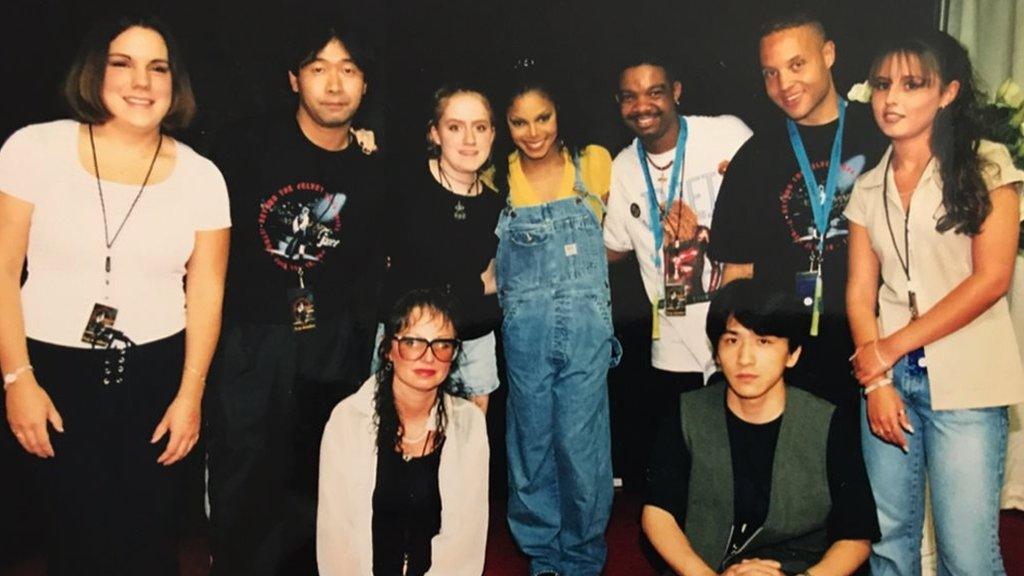
Christine Cardona (far right) and other fans meet Janet Jackson in 1998
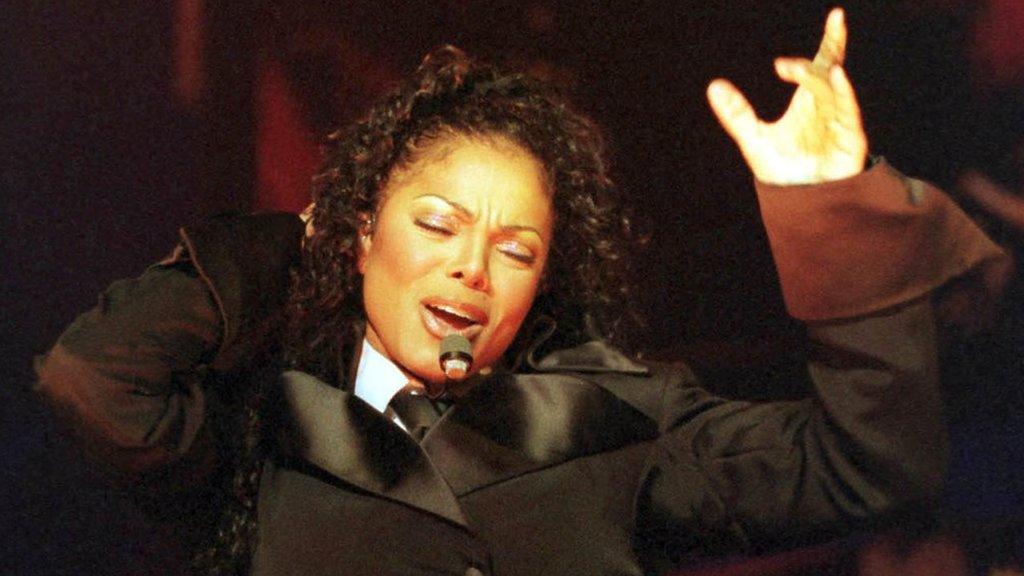
The Velvet Rope tour was seen by more than 2 million people in 1998
When Janet released her next two albums (2001's All For You and 2004's Damita Jo) I was attending Boston University with one of the Janet fans I'd met in Detroit. We were taking sketchy $20 bus rides between Boston and New York City every few weeks for an endless blur of album signings, talk show appearances and performances. We'd sleep outside in lines on city sidewalks, near parks, under brightly-lit marquees and the fans' camaraderie on those nights stays with me. We took care of each other.
I was taking my first women's studies classes during "Nipplegate" - that infamous Super Bowl moment when Justin Timberlake ripped open Janet's bustier and exposed her nipple to the world. We were specifically asked not to mention it in our work. The instructors had tired of it, or felt it was too ripe for plagiarism. I remember feeling it was a very specific sort of slight. The country was suddenly in the grips of Janet and her (literally) star-studded nipple, and I couldn't discuss it.
I don't even know if I understand in present day all the implications of that nip slip - of what it says about how women's bodies are regarded (or disregarded); about society's fears of women as sexual beings, particularly black women; and about the way culture selectively chooses when to be prudish and when the sexualisation of women is marketable and acceptable.
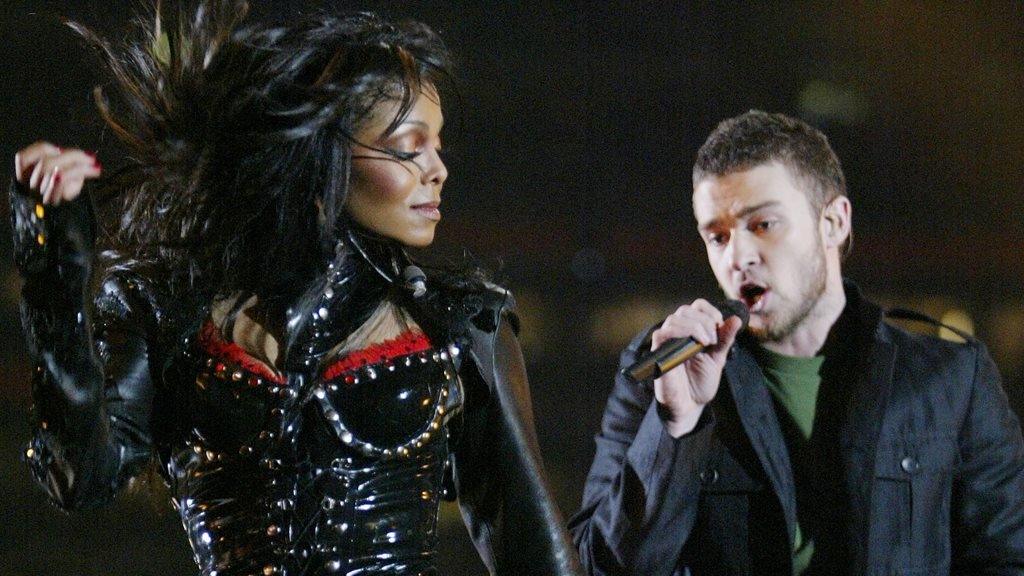
The Super Bowl incident derailed Jackson's career in the US for several years. Timberlake emerged unscathed
After college, I won a fan club contest to meet Janet again, and was flown with my friend to Las Vegas. After some professional obligations, she retired to a private balcony with us, a few assistants, and several friends.
We stood together at the edge of a railing, and I scanned her face (OK, I was blatantly staring), watching her derive satisfaction from looking at the crowd below, dancing to her music. We took a tequila shot, and talked briefly. She was kind, generous with her time.
This time, I found more words than "thank you". The club was loud, and she leaned in close, almost cheek to cheek, so I could hear her famously quiet speaking voice. She encouraged me to pursue a career in television. She referenced her favourite parts of my competition entry, and I couldn't believe she had read it.
It was a life highlight, but I still couldn't shake the feeling there was something I needed her to know, something I still hadn't been able to communicate.
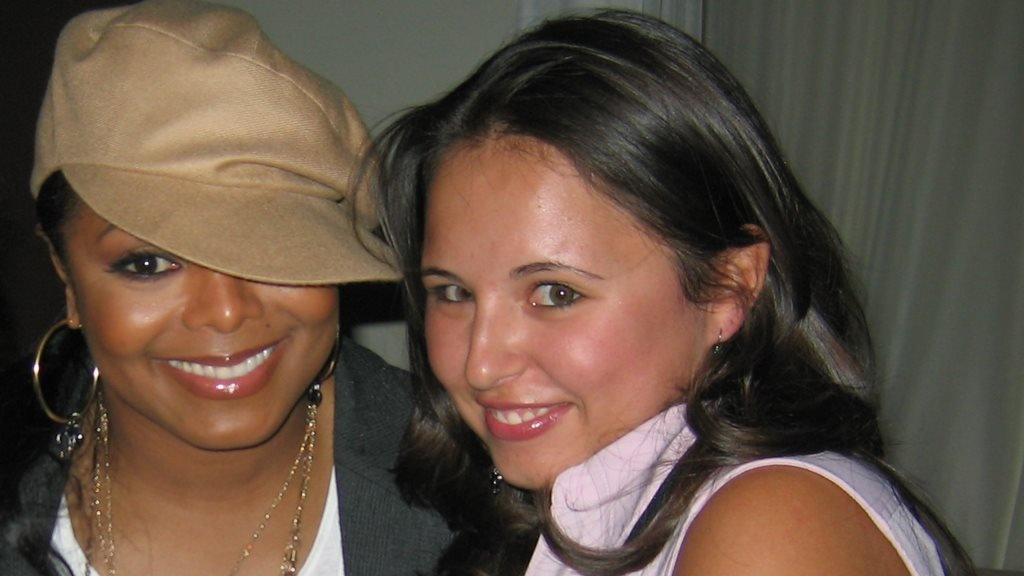
Backstage in Las Vegas with Janet Jackson
Shortly after Vegas, I moved to New York City to try out that whole working-in-television thing. As my life picked up, I did fewer fan-related things. There were fewer of them to do - Janet disappeared and reappeared, weaving in and out of my life as her focus shifted away from music.
In 2015, I was in my early 30s, searching for a way to ease newfound anxieties, when Janet's Unbreakable album was released. Her first record in seven years, it reminded me so much of The Velvet Rope - confident, yet vulnerable; reflective, but uninterested in other people's opinions.
Aged 49, she had changed personally, vocally, and musically, but she was also, unmistakably the same Janet I fell in love with. For me, the most endearing part of the project was that it represented growth, not reinvention - the kind of growth and self-actualization we all strive for.
I caught the Unbreakable Tour in Chicago and planned to see it again in New York, but Janet had some health issues followed by her pregnancy and the tour flickered out.
When it was announced she would resume live performances so soon after giving birth (and getting divorced), I was surprised. I didn't imagine her coming back so quickly. At the urging of friends, I decided to take a last-minute chance on the opening night in Lafayette, Louisiana.
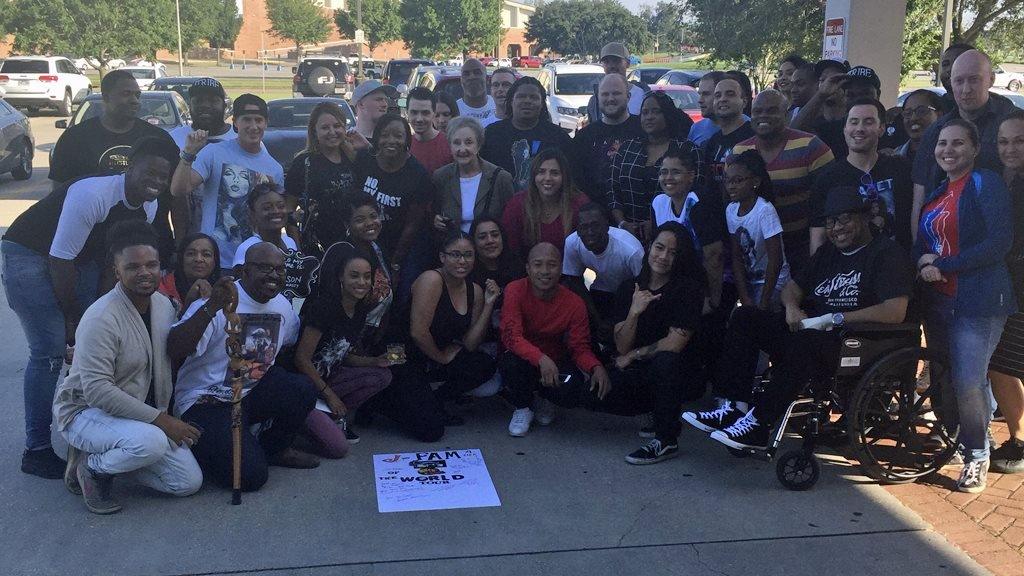
Fans became friends, meeting up for the first night of the State of the World tour - with Janet's dancer Gil Duldulao front and centre

Christine will be attending the last night of the tour on Sunday
The State Of The World tour mixes old songs that have never been played live, with others that have lain dormant for almost 30 years, alongside new material. It's all-encompassing, and it highlights a lengthy and exhaustive career. This woman owns the stage for the full duration. Her dancing is mesmerizing, external - the particular mixture of old and new choreography is masterful. She's out there "milly rocking, external" in a way that puts kids to shame. My bias is mine, but the reviewers seem to be with me, external.
But something is different on this tour. I think people, including me, didn't expect to see her out here like this again. They've been dressing as different versions of Janet, wearing fun and thoughtful custom shirts. I've even invested in a gold key earring and some "State of the World" lip colour. Wearing them makes me so damn happy, I feel like a kid.
I think we're all doing a bit of self-soothing under the security blanket of nostalgia, but we're also really thrilled that whatever this thing is, it isn't entirely in the past. The magic is still happening and that brings a distinct sort of satisfaction. The joy of having these songs and experiences to grow with is what I'd been trying to express to Janet all along.
So many of us have stories about the ways Janet made us feel heard or accepted, or how she's left her mark on us. At 51, she may be embarking on her first journey through motherhood, but she already has generations of people who feel, at least a little bit, raised on Janet.

So far, the State of the World tour has been restricted to the US but fans are hopeful that more dates will be announced

Follow us on Facebook, external, on Twitter @BBCNewsEnts, external, or on Instagram at bbcnewsents, external. If you have a story suggestion email entertainment.news@bbc.co.uk, external.

- Published2 May 2017
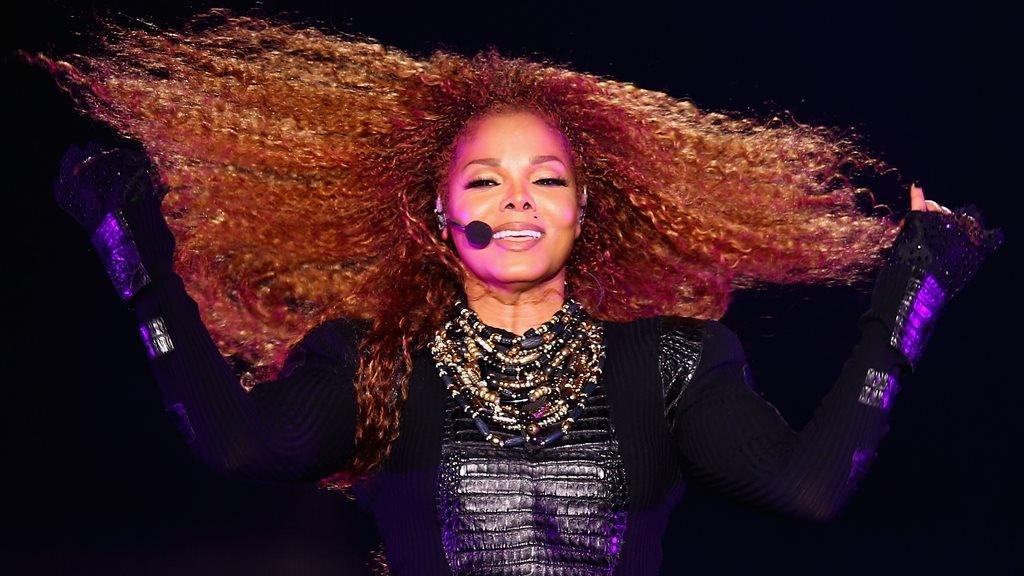
- Published2 October 2015
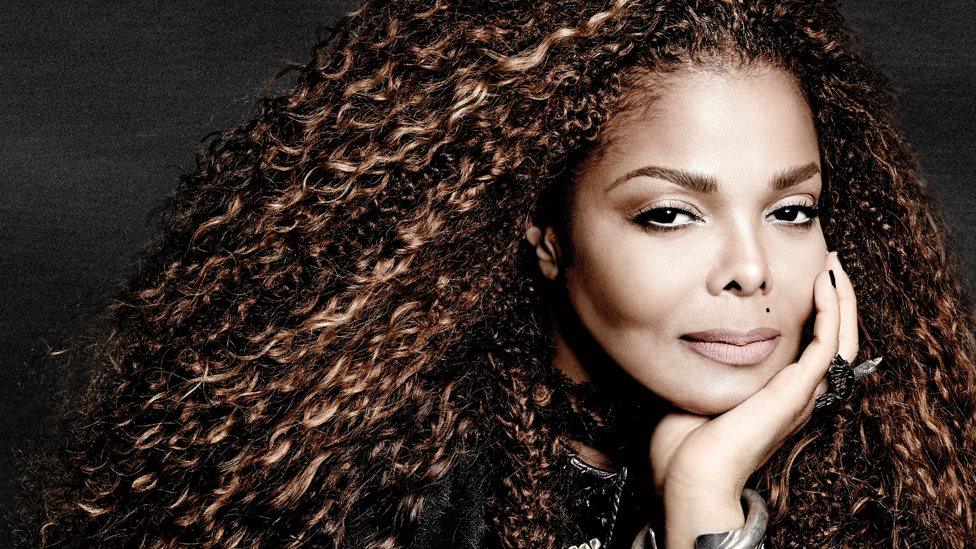
- Published3 January 2017
